





Once out on expedition, this page will be updated with photos and diary entries from out on the mountain so you can keep up to date with events as they unfold. For full history - go to bottom and work up....

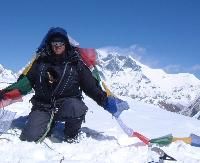
I'll be climbing from the Tibet side. Base Camp will be set up on the Rongbuk glacier at 5,200m, with an Advance Base Camp set up below the North Col. Several progressively higher camps will be set up high on the North Ridge. The long, cold and technically challenging Summit day will begin around 2am with summit target of 11am.
I'll be leaving for Everest at the beginning of April 2006. All things going well summit day will be around late May. Back in the UK mid June.
The above photo was taken from the summit of Mera Peak, Nov 2004, the summit in the background is Everest - the 'plume' of cloud is jetstream hitting the summit.

Technology allowing you should find regular updates from Everest Base Camp below. However if there's no news then try linking to the expedition company update at www.adventurepeaks.co.uk or more general news at www.mounteverest.net
Sunday 2 April 2006 - Departure day!
Thursday 6 April 2006 - Already in Tibet in a town called Nylam at 3,700m. It's been an exciting first few days!.....
We were delayed in our arrival to Kathmandu, Nepal, so arrived very late on Monday night. Because of impending strikes and roadblocks nationwide we had to leave Kathmandu as soon as possible to reach the border with Tibet. The strikes are linked to the Moaist rebel movement and likely to cause much disruption. Tuesday was spent gathering last minute gear and packing the trucks that carry the gear. You wouldn't believe the amount of gear - a full large lorry load!
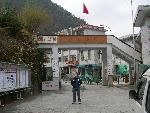
Within half an hour everything began to return to normal and we legged-it in our bus in the other direction from the trouble. Within 5kms we were through a secure army checkpoint and were soon at the border.
Keeping things in perspective, it seems the approaching strikes is increasing the friction between the government and the rebels. Also the trouble is resticted to remote parts of Nepal only. Now we're in China the trouble is behind us. (So Mum / Is - don't worry!)
As far as Tibetan China goes - things are pretty basic but food has been good so far! Tomorrow is an acclimitisation walk day before we move further into Tibet on Saturday.
Tuesday 11 April 2006 - We arrived in Base Camp yesterday at around 5,200m. Despite the high altitude headaches it's good to be here. The accommodation and food since arriving in China has been prescribed by the Tibetan Mountaineering Association and has been pretty basic. Here in BC we're pretty much self-sufficient so much better food, our own tents and even the shower should be working tomorrow! ..... there's even a Post Office here too - though nobody seems to know when it's actually open!
Since the last update we've travelled through some of the most basic and remote parts of the world I've seen. The Tibetan plateau gets little rainfall and with an altitude over 4,000m is barren and dusty.
The first views of Everest summit from BC were glimpsed before cloud and wind came in bringing a snow dump in the evening. Temperatures not too bad when the sun is out but drop well below freezing when the sun sets. It's pretty windy all the time.
There are a number of teams here scattered across the massive area at the snout of the Rongbuk glacier. We've a few days acclimatisation here before moving up to Advance Base Camp at the weekend.
Friday 14 April 2006 - We had our Puja ceremony yesterday. A local monk attended our camp and blessed the expedition, our climbers and equipment. The ceremony
culminates with prayer flags being raised and the sharing of the offerings amongst the group. It was fun but pretty cold as it was held outside and we continue to experience strong winds.
The last few days have been spent acclimatising. Earlier today I climbed to just over 6,000m - great views of Everest and Pumori in the distance. These acclimatisation climbs where we climb high during the day but sleep back down at BC should help reduce the impact of altitude sickness as we move up to ABC for the first time which begins on Sunday.
Tuesday 18 April 2006 - We arrived at ABC yesterday so our tents are now at 6,300m. ABC is situated on moraine at the side of a glacier below the steep ice face to the North Col (Camp 1). It took two days to get here from BC and it has been tough going, getting much colder and slower with altitude. It's been snowing since we arrived and around 50mm fell overnight.
We'll be here for the next week or so acclimatising before we return back to BC for recovery. During the time here we aim to climb a local peak called Lhakpa Ri (just over 7,000m) and then move up to the North Col for a night's sleep (7,010m). The climb to North Col will be tough as it's a steep climb. A Sherpa team has already been up and fixed secure ropes to it however. Once we've slept up there we return back to BC.
Before moving up here we had a day's training on the oxygen system we'll be using higher up in a few weeks' time, and on using the PAC (Portable Acclimatising Chamber) which may be used if there are any medical problems as it simulates a 2,000m descent.
Friday 21 April 2006 - Currently at Advance Base Camp, 6,400m. The last few days have been spent doing acclimatisation climbs in poor weather......continuous snowfall and strong winds making it hard to stay warm. These harsh conditions have impacted on health - we all have minor ailments of somekind. Having been away from BC for a while now, a number of the team have descended.
However!, today is a rest day, the sun is shining and the mess tents are now set up pretty comfortably! I have my ipod on loudspeaker and it's great to spend time feeling the body recover and benefit from the acclimatisation work.
Yesterday five of us moved out onto the glacier below Lhakpa Ri (a nearby 7,000m peak) to assess the possibility of a summit attempt of this 7,000m peak. It was a very tough day involving moving through crevassed areas roped together for safety. We may consider going for the top in a few days time. The British Army team are attempting the summit
today so we will watch their progress (over cups of hot tea) and catch up with them post climb to get the low-down.
Tomorrow I will be tackling the route from ABC to the North Col (over 7,000m - higher than any point outside the Himalaya) for the first time. I expect this to be one of the hardest days and hope that recent acclimatisation to date and today's rest will pay dividends. The route moves up the moraine to the right of a large glacier beneath the Col, then we will move up onto the glacier itself and traverse over to fixed ropes that have been put in place up the headwall. The top of the headwall has three large crevasses, some of which have been laddered, before reaching the area that we will sleep at on the next ascent.
Monday 24 April 2006 - Altitude acclimatisation is a funny thing! I attempted a climb to the North Col on Saturday. It took about 3 hours to reach the headwall at 6,550m after crossing a pretty dodgy glacier (the route across it is peppered deep holes into underlying glaciers - however the ice bridges appear strong). At the foot of the headwall I already felt absolutely exhausted and still had a 500m climb up fixed lines and steep ice to
reach the North Col. By 6,850m I was finished - things didn't feel right - I turned back. I'm glad I did as by the time I reached the ABC tents my co-ordination wasn't good. That said I was disappointed not to reach the North Col on schedule.
Anyway, on Sunday I set out again towards the headwall. Despite the events
of the previous day, this time I felt good at the bottom of the headwall and successfully reached the top. The headwall is a very steep ice wall and has been roped with two fixed lines from bottom to top. As the climber makes their way up the ropes a mechanical device is used to protect them in the event of a fall (though you still wouldn't want to fall since there can be several climbers on a rope at one time). The top of the route currently has a couple of gapping crevasses, one spanned by three long ladders strapped together
at around 7,000m. It was great to reach the top at around 7,030m. The North Col will be the site of Camp 1. The aim will be to sleep on the North Col and make further acclimatisation climbs from here on the next assent in a week's time.
Today I returned to Base Camp, back down at 5,200m, for some much needed rest and recovery. The walk down was 22kms - but felt much longer after the last two days climbs. I'm suffering from a chest infection, badly cracked lips and nose, and in need of fresh fruit and veg which is lacking at ABC following the bad weather earlier in the week which
ruined the supplies taken earlier.
Looking forward to a day's leisure at a local monastery tomorrow!
Wednesday 26 April 2006 - The whole team is currently back down at BC for some much needed rest and recovery. Eating loads and enjoying the thicker oxygen. I will be
travelling back up to ABC on Sunday, probably, with a plan that sees me sleeping up on the North Col at 7,000m then up at the next camp at 7,500m.
Yesterday I had my first much needed wash since leaving Kathmandu over three weeks ago - so smelling fresh again! - for a while.
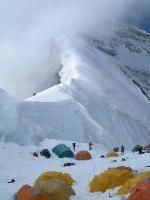
are the highlights of the last few days...
Saturday - Moved from BC (5,100m) to ABC (6,300m). A 1,200m climb over 22kms. I found this really tough. Despite being acclimatised from the last trip to ABC the walk in is exhausting and unrelenting. It took around 7.5hrs and the last 2hrs were in poor weather with snow and poor visibility. It took a long time for my heart rate to reduce to normal (at least for this altitude) and I was glad of the rest day the following day.
Monday - Moved from ABC to North Col (7,050m). Patricia and I were the first in the team to move to the North Col to sleep.(See picture above of North Col). Given I was going to be sleeping at the North Col I was carrying a heavy sack with high altitude sleeping bag, down suit, and other personal climbing gear. The climb up the fixed ropes on the headwall was tough and there were delays as slower climbers created bottlenecks on the fixed ropes. The top of the headwall was particularly slow (especially up the final steep section and the laddered crevasse) and by this time the weather had closed in. Arrived on the North Col in high winds and snowstorm. It was very cold with low visibility and high winds lifting much of the fallen snow as wild spindrift. We quickly set ourselves up in one of the tents, getting hot water on the go.
The North Col is basically an area around 50m x 20m. It is situated on a serac (a consolidated ice shelf) and has another serac hanging above it which provides some shelter from the wind. Our three tents are situated on the very edge of the serac (you wouldn't want to go out the back door!). The first night up there was particularly windy and spindrift snow made its way into everywhere!
Tuesday - We had planned to move up to Camp 2 (7,500m) today. However Patricia was suffering from altitude problems having not been to the North Col to acclimatise prior to sleeping here and decided to move back down. Not being advisable to move to C2 on my own (in case of an emergency) I decided to move half way up to C2 and return to the NC that night, and await several other team members who were moving up to North
Col today. I climbed to 7,300m up the fixed ropes on the Everest North
Ridge. I was glad to find that the full down suit and summit boots I have
with me kept me warm despite the cold and winds. I returned to NC camp
around 3pm.
Climbing at this altitude is pretty hard on the body. It's not so much the physical exertion, which training back home has prepared the body for, but the exertion on the respiratory system and mental fatigue. The heart beats hard and fast and the lungs burn as they try to take oxygen from the thin dry air. Even so the muscles are starved of oxygen and all
movement is slow. A painful hacking cough can be heard around camps at
night.
Wednesday - Our two climbing Sherpas set out early morning to establish our camp at C2. However they returned soon after as the winds on the North Ridge and C2 were too strong. In any event, Conan and I decided to climb to C2 anyway. The reason - I was concerned about staying too many nights at NC (which noticeably reduces one's strengths) and wanted to gain further acclimatisation up to 7,500m (1,400m below the summit). I was concerned that further bad weather would mean a descent from NC
without the opportunity for further acclimatisation.
The route was hit hard by the winds, however although strong these were cross-winds. Reached C2 at round 3pm (a five hour climb). The exposed parts of C2 were pretty barren with the remnants of wind torn tents!
Didn't stay long at C2, but did take in a fantastic view. At just below 7,600m, there aren't many nearby peaks that get in the way.
The descent was the worst weather-wise. The wind would blow spindrift into the face which then freezes on the beard! Nice - but didn't stop for photos!
Thursday - After three nights camped on the North Col I decided to descend. Over the next few days our whole team will descend to BC and await forecast of the weather window and out final summit attempt.
Tomorrow I will make the 22km trip back to BC and the luxury of higher O2 levels, warmer weather and good food. Looking forward to it!!!
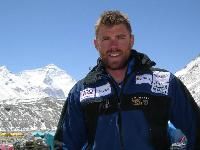 Sunday 7 May 2006 - I'm now back at Base Camp along with three other teammates - Conan, Rob and James. We've all been up onto the North Col, slept there and made acclimatisation climbs above North Col. Conan and I having reached the next camp at just below 7,600m and James and Rob having reached 7,300m before bad weather came in and caused their descent.
Sunday 7 May 2006 - I'm now back at Base Camp along with three other teammates - Conan, Rob and James. We've all been up onto the North Col, slept there and made acclimatisation climbs above North Col. Conan and I having reached the next camp at just below 7,600m and James and Rob having reached 7,300m before bad weather came in and caused their descent.
I ended up spending three nights on the North Col at 7,050m and made two acclimatisation climbs above there. I felt good up there, but just being at high altitude has quite an impact on the body and I really felt the effects on the move down from ABC to BC. Although the move down is at a much lower altitude and downhill, I was absolutely shattered - just seemed to have little in reserve having been at high altitude for a while... Needless to say I'm now enjoying the rest and recovery period at BC!
Other members of the team are currently still at ABC and above, completing their acclimatisation prog and will hopefully be down at BC with us soon.
We are now eagerly awaiting the daily weather forecasts ahead of the final summit push. We get a daily short and long-term forecast. Ideally we want to try and rest and recover here for about 5 days, then hopefully receive a forecast predicting a weather window such that we'll set off with a view to summiting. Once we receive news of the weather
window, we'll try and make the following moves ..... Day 1:move to ABC 6,300m,
Day 2:rest ABC, Day 3:move to North Col 7,050m (Camp 1),
Day 4:move to Camp 2 at 7,800m, Day 5:move to Camp 3 at 8,300m,
Day 6:summit attempt 8,848m....
I'll be using supplementary oxygen at varying flow rates from when I leave Camp 2. So will be on O2 for the climb to Camp 3, overnight at Camp 3, then throughout the summit attempt.
For now we're simply relaxing at BC. Our cook here, Gannu, is excellent
and we've all been helping him add to his portfolio of Western meals. Yesterday was my turn so it was a Yak Stew "Scott Style" - luckily this proved to be a hit with the others!
Wednesday 10 May 2006 - All seven of the team are now at Base Camp and we await a clear sign of a summit weather window in the long-term weather forecasts. Nothing
definite at the moment so we are sitting tight.
Two team members, Rob and James, are both attempting to be the youngest
Britons to summit Everest and there is building news interest in their attempt - local radio, tv etc. The other day we recorded a short news item which is possibly going national on kids tv "Newsround" as it's Rob's 19th birthday today. ...... we'll be using this as an excuse for a few beers later this evening!
Personally, I'm hoping news of the weather window comes soon as I'm keen to get on with things....
Thursday 11 May 2006 - You may have seen from some of the Everest news websites such as www.mounteverest.net and www.everestnews.com that the Korean team have
summitted earlier this morning.
In addition there are a number of other teams primed to make summit attempts over the next few days. There will no doubt be much activity reported over the next week.
Although our weather forecast still shows moderate winds, the mornings are typically calm and we are planning to make our attempt too.
We leave tomorrow for ABC and will continue up from there - weather depending.
I will not be able to give updates once we leave ABC, but watch this space and other related sites for news.
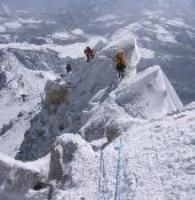
some of the hardest, most exhausting, exciting, exhilarating and emotional
days of my life.
There seem to have been so many events packed into these few days ....
Friday 12 May 2006 - We had completed our acclimatisation program and
were waiting at Base Camp for indications in weather forecasts of an
obvious weather window for a summit attempt. The summit of Mount Everest
is usually hit by the extreme high altitude jet stream winds making
getting there impossible. However around the end of May weather changes
related to monsoon and other activity usually gives rise to periods of a
few days where the jet stream moves away and local weather may allow
access. It was this window we were looking for. Unfortunately weather
forecasts never showed a clear window - but with the team being ready we
decided to focus on the 17th May where summit conditions looked best
(though not great). We left Base Camp for Advance Base Camp on Friday 12
May.
Although this was the third time I'd made the move from BC to ABC
(6,300m) and was fully acclimatised to heights well above there, I still
found the trek tough. It's a 22km move gaining 1,200m at high altitude.
In any case I made ABC in about 5.5hrs which is a decent enough time.
Saturday 13 May 2006 - A final preparations and rest day ahead of moving
to other camps. In previous acclimatisation climbs I had already carried
equipment needed higher on the mountain, to a camp set up on the North
Col, so final preparations mainly concerned that the essentials were definitely
in place. I also checked through the oxygen system I'd be using, making sure it
was fitting and working properly. We used a traditional Poisk system
which has been well tested in past expeditions, simple to use, and used
by most other expeditions.
Since the expedition began I've been paranoid about illness and eating
well. For some, the change in food and diet can ruin their chances.
Altitude typically reduces appetite, and the resulting weight loss and
drain on energy reserves are crippling over the long time involved on
Everest. In the months between the Aconcagua expedition in January and
departure for Everest in early April I'd put some weight on - knowing it
would fall off in the first few weeks. Once on expedition I pretty much
ate whatever was put in front of me, however I was feeling. This worked
well and I've maintained much of my weight. But the day before we
departed on our summit bid I was crippled by a stomach upset ......
luckily this appeared to be a 24hr thing, but it had me seriously worried
and wasn't great karma!
Sunday 14 May 2006 - Moved from ABC to North Col (7,050m). I'd already
spent several nights in our North Col camp so found the move relatively
easy. It was a hot day though and the strenuous climbing up the 550m of
fixed ropes on the headwall was a challenge. I shared a tent with Conan.
The tents here have been up a few weeks now. The extreme weather up
there has led to the tents being snow buried and the walls of the tents
have buckled under the weight of snow. As a result they are pretty
uncomfortable.
Monday 15 May 2006 - Moved from North Col (7,050m) to Camp 2 (7,800m).
Undoubtedly one of the toughest days so far. I'd done an acclimatisation
climb to almost 7,600m previously, but even so the climb to 7,550m took
several hard hours. Everyone was pretty exhausted and there was still
250m to go. To make things even harder there were some tents belonging
to other expeditions set out from 7,600m up to our tents (pretty much
the highest at the camp) at 7,800m. The route up this part of the
mountain meanders back and forth over steep ground making for a slow and
difficult climb. Again I shared a tent with Conan. The night was another
uncomfortable one. We struggled to produce hot water needed to rehydrate,
make meals and prepare water bottles for the next day.
The team used canistered gas and simple stoves (rather than more
complicated pressurised stove systems I've used in other high places) on
the basis that they would be less likely to breakdown. However we found
that the reduced air pressure, and impact of temperature made using them
a slow process. Also we were experiencing high winds making cooking in
the tent entrance difficult with snow and ice entering the tent.
Strong winds continued during the night. All team tents were fine, though
several other tents in camp were fallen.
Tuesday 16 May 2006 - Moved from Camp 2 (7,800m) to High Camp 3 (8,300m).
This was a critical day. On leaving camp all team members began using
their supplementary oxygen supply. We would be entering the 'Death Zone'
above 8,000m almost straight away. As a result, as soon as we left camp
we were committing to our summit attempt due to our oxygen supply
limitations.
Psychologically I was struggling here. I was feeling weak after the
stomach upset I'd had, and with uncomfortable nights and lack of food and
water, I felt low on resources. In addition the strong winds during the
night concerned me given the impact on our summit chances. Should I wait
for the 18th?
I was slower in leaving camp than others as I mulled over what to do.
Nuru, one of three high altitude climbing Sherpas soon helped me sort out
my dilemma. "All climbers go today. Weather good. Later not good". Those
few words of wisdom convinced me - I was off and quickly caught up time.
I found the oxygen system pretty comfortable. I carried a 4ltr canister.
At a normal flow rate of 2lt/hr this would last around 8hrs. I used a
flow rate of 1.5ltrs on the climb up and reduced this to 1ltr while
resting at High Camp.
There were three of us in the tent, Conan, Patricia and me. We arrived
mid afternoon and again struggled to produce enough water. In the
cramped and cold conditions we managed to create enough water for one
packaged meal, and 1.5lts of luke warm water each. As far as sleeping
goes I was relatively comfortable (despite sleeping with full oxygen
facemask) and managed 2hrs broken sleep before getting up at 9.30pm for
a 10pm summit departure.
This was it. Game on!
I'd already prepared for departure, before sleeping. I'd been sleeping
fully dressed in summit gear for the past two nights anyway - including
full down suit, climbing harness and gear, camera and batteries etc!
I loaded my rucksack with three new oxygen cylinders. Two 3ltr and one
4ltr. I set the oxygen regulator to a 2lr/hr flow and set off.
Wednesday 17 May 2006 - Summit Day 8,848m.
By midnight we were well into our ascent onto the summit ridge. Winds were
relatively low with just spindrift blown ice in the air. The temperature was
around -35C. Things were going well. When we reached the actual summit
ridge I stopped to fix a small problem with my oxygen mask and to warm
my toes (which were the only points feeling any cold).
Almost immediately upon reaching the ridge I came across the first body.
It was quite a shock to come across the body, since in the darkness it's
difficult to see anything until it enters the light of the head torch 10
feet away. His legs and booted feet lay across route. I don't know what
had happened to him except that it was recent - his boots were pretty
new.
In total I saw four different bodies on the summit ridge.
I approached the 2nd Step - a notoriously hard part of the climb - just
before light. About 15mins before the foot of the Step I changed oxygen
cylinders. I'd pretty much finished the 3ltr I'd started with so swapped
to my 4ltr. This would give me 8hrs on a standard flow so decided to
leave both my empty and remaining 3lr cylinder in the snow to collect on
the way back down. As the 2nd step is difficult it is recommended to
increase the flow rate for a short period to 4ltr/hr. I could see there
were half a dozen people already waiting to climb - and some slow
climbers on the route, so I set it to 3ltr/hr.
I waited a long time at the foot of the 2nd Step. I don't know how long.
This gave me two problems. One - my flow rate was still going at
3ltr/hr, and, two - being bored I decided to mess around with my camera
....... this led to me dropping one of my down gloves off the North
Face. The glove issue was plain stupid. I've worried about getting these
things safely tied to my down suit for weeks! Anyway, I decided the
weather looked good, I had a spare pair of light gloves, and I'd deal with
the problem (if I needed to) later.
I found the climb up the 2nd Step pretty easy, though it is technically
challenging, with an exposed section over the North Face and a long
ladder that doesn't actually reach the top.
Once over the 2nd Step it was technically easy over the 3rd Step and
then onto the final summit pyramid. Feels like you're almost there, when
the route takes a winding and exposed last section. I remember feeling
pretty emotional here. All sorts of things racing into the mind as
you know you're going to make it......
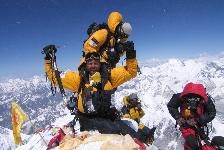
reached the summit at around 9.45am (about 11hrs after leaving camp)
along with Conan and Sonam (our youngest Sherpa at 20 years old, and his
first Everest summit). I was on the summit for around 20mins. Quite a
view and a strange experience!! I wonder if I'll have that same feeling again.....
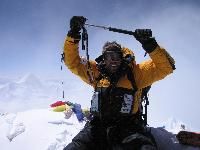
out of oxygen just before descending the second step. Only 15mins from
my remaining bottle, but not good. It wasn't a surprise, I was watching
my supply carefully after I had been on an extended flow while queueing
at the 2nd Step on the way up.
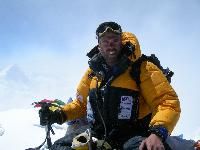
plate in order to abseil down. As I reached the end of the rope, one of
my feet got tangled in old ropes. Things got difficult, and without
supplementary oxygen I wasn't feeling too happy about spending time
sorting the situation. In the end I removed the abseil protection and
down climbed free. By the time I'd abseiled the second section I could
feel the effects of no oxygen supply. I put my regulator to max in order
to draw any remaining oxygen and by the time I reached my stash I was
moving pretty slow.
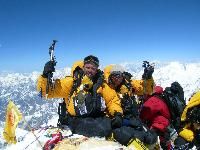
ahead that I was moving a little slower following the effects of not
having oxygen for a while.
Sonam and I soon reached the 1st Step. When descending back down fixed
ropes I tend to wrap the rope around one arm and around my back. I use a
short sling and karabiner as a safety back-up. Anyway, on the 1st Step
my footing slipped. As a result I fell in the direction of the rope
rather than the route ..... not a nice feeling, as there was a slight
drop below! Anyway three fingers trapped into my safety karabiner and
the fixed line soon took the strain. Sonam was a star player and help me
traverse back onto the route. To be fair, I was absolutely exhausted and
would advise others to formally abseil the 1st Step!!
I was back in High Camp 3 around mid-afternoon. We collected some gear
that was left here and descended further to Camp 2 at 7,800m. A much
safer place to spend the night and, critically, below 8,000m.
I spent the night in a tent with Rob and James. At 19 years old they had
both just reset the British record books as the youngest Brits to summit
Everest. We were all exhausted.
Thursday 18th May 2006 - Camp 2 (7,800m) to ABC (6,300m). Another tough
day. Exhausted, dehydrated and hungry we made our way from Camp 2
through Camp 1 to ABC. The move between Camp 2 and 1 was tough. A snow
storm came in and we were left to literally follow a fixed line into the
whiteout.
Anyway I eventually reached ABC. Job done.
I called Isabelle and my Mum. To be fair I don't think it has sunk in
yet. It doesn't feel real, and we still need to get back to Base Camp
and eventually back to civilisation. I'm looking forward to it sinking
in!!!!
Isabelle and my Mum have been keeping me up to date with all the
tremendous support coming from back home. In case I forget to say it
..... thank you all for your support this far.
Tuesday 23rd May 2006 - The whole team is now down at Base Camp. Higher altitude camps have been dismantled and we await a Yak train to transport gear down from ABC to BC. Once all our gear is here we await transport provided by the Chinese Tibetan Mountaineering Association (CTMA) which will escort us to the border with Nepal at Friendship Bridge. We hope to be in Kathmandu towards the end of the week at which time UK bound flights can be re-organised. Basically it's a bit of a logistics nightmare with many expeditions now ready to leave at the same time.
To be fair, I won't be sorry to leave Base Camp - it's been a long time since we arrived in early April! In this post-climbing period it almost has the feeling of a war zone. Teams are left to count the cost of this years' climbing season. We have been fortunate. It is difficult to obtain clear accurate information but it would appear that the number of fatalities on this, the North side, must be approaching double figures. I've no idea what has happened on the South side of the mountain. Many teams have lost one or more climbers. On top of this some teams are reporting climbers with frostbite and other injuries.
Yesterday a Nepalese helicopter landed in camp during part of an operation to recover the body of a Norwegian from the mountain. For fear of mis-reporting I won't go into the details I'm aware of regarding other fatalities and injuries.
I'm not sure what official statistics would say, but since records began I think around 2,500 people have summitted Everest, of this less than 100 Brits. Traditionally the North side of the mountain has been less popular than the South side. In the past climbing permits and logistics were easier from the South side (Nepal), but now climbers can make
attempts from either side (Nepal or Tibet/China). The South side is more dangerous in its earlier stages (through the Khumba Icefall) however the North is more technical (particularly on Summit day and the three Steps) and involves a longer Summit day and sleeping in high camp above 8,000m inside the "Death Zone" (in fact this year at least one climber suffering a cerebral oedema on Summit day was rescued to top camp,
however this drop in altitude was not sufficient).
One thing is for sure - although climbing permits may be more accessible to those climbers willing to attempt the mountain (and so there is an increasing number of climbers each year), the mountain itself has not changed, there is little change in the way the mountain is tackled, there has been little change in the nature of equipment used, and so the physical and psychological challenge of the climb has not diminished......

Lots of Support - March 2006
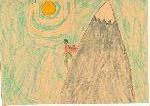 As time gets closer to the departure date I've been getting lots of great messages of support. Here's a picture of the Everest North Ridge! ..... Nice one Jocasta! ..... I'll certainly be hoping for a sunny day like that.
As time gets closer to the departure date I've been getting lots of great messages of support. Here's a picture of the Everest North Ridge! ..... Nice one Jocasta! ..... I'll certainly be hoping for a sunny day like that.
Back in Scotland with the boys - March 2006
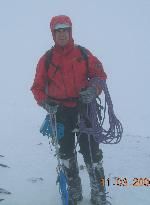 Back up for one final four day visit in Scotland before departure for Everest. It was great conditions though. Cold, lots of snow, high winds and low visibility! Luckily I had willing partners to climb with, so we were out in whatever the weather could throw at us. The picture here was taken at the summit of Stob Corrie nan Blieth after ascending North West Gully with Mick Allen. No avalanches this time!
Back up for one final four day visit in Scotland before departure for Everest. It was great conditions though. Cold, lots of snow, high winds and low visibility! Luckily I had willing partners to climb with, so we were out in whatever the weather could throw at us. The picture here was taken at the summit of Stob Corrie nan Blieth after ascending North West Gully with Mick Allen. No avalanches this time!
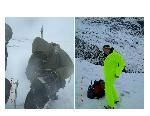 The boys - Neil Hunter taking a much needed bearing in bad weather. Mick Allen sporting his new 'climbing suit' ..... don't ask!
The boys - Neil Hunter taking a much needed bearing in bad weather. Mick Allen sporting his new 'climbing suit' ..... don't ask!
BDO Takes Interest Internationally - February 2006
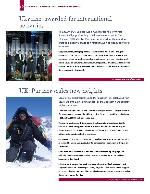 The BDO organisation employs nearly 28,000 employees internationally, with more than 600 offices in over 100 countries. In February an event profile ran in the international news letter.
The BDO organisation employs nearly 28,000 employees internationally, with more than 600 offices in over 100 countries. In February an event profile ran in the international news letter.
It was great to get some exposure - and some welcome support from the overseas offices. You can see some of the messages in the Guestbook
MountEverest.net - February 2006
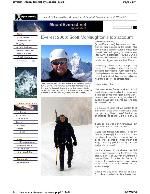 MountEverest.net one of the best websites to cover news and events on Everest. In early February they ran a short web-interview. Click here to read more....
MountEverest.net one of the best websites to cover news and events on Everest. In early February they ran a short web-interview. Click here to read more....
Avalanche on Tower Scoop - February 2006
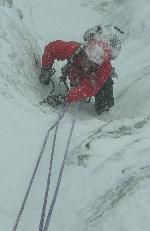
The picture here was taken just after.
Subsequently a couple of guys we'd met earlier in the day logged the following blog entry....Tower Scoop

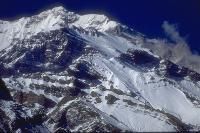 Aconcagua is the highest peak in the Southern and Western hemispheres, and the World's highest peak outside Asia. It reaches 6,962m, or 23,000ft, above sea level.
Aconcagua is the highest peak in the Southern and Western hemispheres, and the World's highest peak outside Asia. It reaches 6,962m, or 23,000ft, above sea level.
This is a technical ascent over snow and ice, and good experience ahead of Everest.
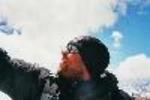 In early December eleven of us set off from the UK, flying via Madrid and Buenos Aires to Mendoza in the mid-East of Argentina - and the nearest town to Aconcagua. A couple of days later we'd loaded the mules and began the three day trek to reach base camp at 4,200m.
In early December eleven of us set off from the UK, flying via Madrid and Buenos Aires to Mendoza in the mid-East of Argentina - and the nearest town to Aconcagua. A couple of days later we'd loaded the mules and began the three day trek to reach base camp at 4,200m.
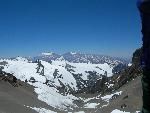 Ten days later and we were based at Camp 2, and acclimatising to 6,000m. We were aware that the weather window was closing and an attempt needed to be made the next day - or risk spending considerable time trapped by high winds.
Ten days later and we were based at Camp 2, and acclimatising to 6,000m. We were aware that the weather window was closing and an attempt needed to be made the next day - or risk spending considerable time trapped by high winds.
Here's the view over the Andes.
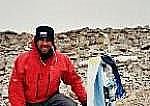 31 December 2005 2.15pm. Summited Aconcagua and the top of the Southern hemisphere. It was a challenging climb and it was great to feel the training pay off as I felt strong throughout. Chris Redfern(Eng), Ryan Maclean(Scot), Phil McKenna (NIrl) and I made it to the summit after a v cold, -25C, 3am wake up. I had the privilege of summiting first and radioing a 'Happy New Year' to the team .... and receiving a big cheer in return! Here’s a picture at the summit cross.
31 December 2005 2.15pm. Summited Aconcagua and the top of the Southern hemisphere. It was a challenging climb and it was great to feel the training pay off as I felt strong throughout. Chris Redfern(Eng), Ryan Maclean(Scot), Phil McKenna (NIrl) and I made it to the summit after a v cold, -25C, 3am wake up. I had the privilege of summiting first and radioing a 'Happy New Year' to the team .... and receiving a big cheer in return! Here’s a picture at the summit cross.
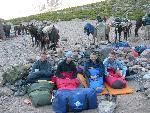 It then took us 4 days to descend to the roadhead, civilisation and some celebratory birthday beers in the town of Mendoza.
It then took us 4 days to descend to the roadhead, civilisation and some celebratory birthday beers in the town of Mendoza.
The picture here shows the lads on my birthday, 4 January, after a night out in the open and our last day on the mountain. Rich, Chris, me and Mick.
The Press Picks Up!
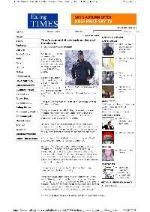 Following the press launch a number of local papers have picked the event up including; in London – Ealing Times; Ealing Herald; in Huntingdonshire – Hunts Post, Cambridge Evening News, Weekly News.
Following the press launch a number of local papers have picked the event up including; in London – Ealing Times; Ealing Herald; in Huntingdonshire – Hunts Post, Cambridge Evening News, Weekly News.
The picture here shows the Ealing Times webpage version.
Press Launch October 2005
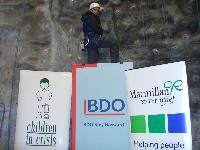
It was great fun!, the next morning I did a short presentation to some of the Sixth Form at my old school.
Summer Training 2005
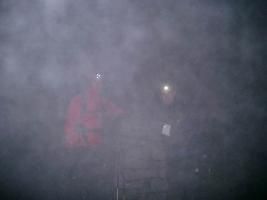
Alps Training 2005
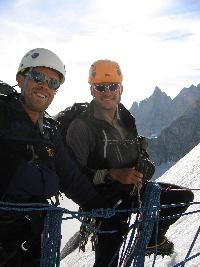
A great bunch of guys to climb with from all over the world - all mad about mountains - you'll see most of them on Ama Dablam, in the Himalaya, later next year.
The photo here shows Olly, our guide, and me half way up a straight forward ice climb.
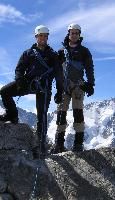
The photo shows Angus and I topping out earlier in the trip.
Scotland Winter Training 2005
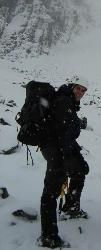
During the winter season I was able to pack a bunch of Munros, ice climbs, and stacks of white-out winter navigation.
Most days were like this! Cold, windy and bleak. Crampons, ice axe, helmet, goggles and full cold weather gear. But It was fun – believe me!
Nepal November 2004
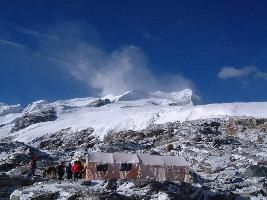
The photo here shows our base camp beneath Mera Peak, on rock below the glacier. From here the summit is two days away - an advance base camp being set up further up the glacier.
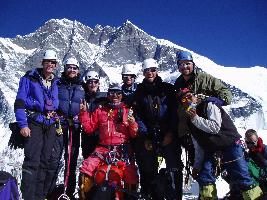
This photo shows the expedition members who made it to the summit of Island Peak. The looming face behind is Lhotse reaching another 1,500m above us. Just out of sight, behind Lhotse, is Everest.
